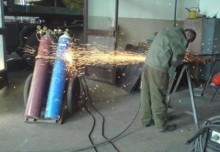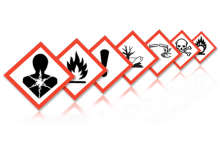 OSHA Recordable waiting to happen!
OSHA Recordable waiting to happen!
Identify and Avoid OSHA Recordable Instances
This article will help you identify OSHA Recordable instances and provide ideas for ways to prevent such instances.
As defined in the OSHA recording keeping standard, 29 CFR 1904.7(a), for an incident to be an OSHA recordable injury, it must meet this basic requirement.
“Basic requirement. You must consider an injury or illness to meet the general recording criteria, and therefore to be recordable, if it results in any of the following: death, days away from work, restricted work or transfer to another job, medical treatment beyond first aid, or loss of consciousness. You must also consider a case to meet the general recording criteria if it involves a significant injury or illness diagnosed by a physician or other licensed health care professional, even if it does not result in death, days away from work, restricted work or job transfer, medical treatment beyond first aid, or loss of consciousness.”
There are often many questions as to what makes an injury an OSHA recordable. There are over 60 letters of interpretation that deal with questions in regards to the recordkeeping standard, click here to link to the OSHA Letters. Some of these questions relate to administration of oxygen, preexisting injuries or illnesses, use of glue as a wound treatment and many others.
Tracking injury statistics can be referred to as a “lagging indicator” for a safety program. Lagging indicator means once the injury happens, there is no way to prevent it. The data and statistics that are generated from recorded injuries tell the story of where you have been, not where you are going. You could argue that by crunching the number of injuries, you can predict where or how the next injury will happen. But that is like driving your car by looking in the rear view mirror when you are driving forward. You can go forward, but not very effectively.
Other lagging indicators include workers compensation costs, days restricted, lost work days, injury frequency and severity. While consulting with a client, the client was explaining an incentive plan they had implemented for management in terms of production rate. There were several plant managers involved and the contest duration was for 3 months (annual quarter). The winning department would hold the title of Best Performing Plant, setting a good example of production and giving the winning plant bragging rights. After the quarter was completed, Plant A was named the winner. Plant A performed better than Plant B and Plant C. However, the Plants were only being judged on production rate. There was no mention that Plant A had several recordable injuries during that same period. You be the judge, did Plant A really perform better? Instituting contests is a fantastic motivator. Contests show the employees you care and are interested, however you must think big picture and ensure contest rules cover productivity and safety.
Instead of using lagging indicators, like injury rates, that tell you where you have been, focus on leading indicators that tell you where you are going. Leading indicators include: near miss reporting, housekeeping, employee discipline, pre-shift safety meetings and management evaluations.
One area that is critical to any safety program is housekeeping. Housekeeping, not only in the sense of washing (washing surfaces/counter tops, washing towels, etc), housekeeping is also the act of picking up debris, tools, cords, wires, hoses as soon as possible or as soon as you’re done using them. You can tell a lot by the appearance of the production floor. Factories and warehouses with clean, neat, well maintained production floors have fewer recorded injuries than the factories that are messy. A colleague mentioned, “if you look at the quality of cleanliness in the bathrooms on the production floor, you have a good indicator of a companies’ commitment to housekeeping”. I have used that observation many times and it proves to be accurate.
There always seems to be a struggle of time, whether measured as production time, idle time, non-value-added time or other determination. Is there a set time planned and implemented for housekeeping to take place near the end of each shift or activity? Do you have the expectation that housekeeping is ongoing as the shift progresses and completed at the end of a shift? Management knows the value of their employees and that their people are their greatest asset, yet their housekeeping is leading to numerous injuries. Employees will trip over hoses or electrical cords left on the floor. Material accumulates on the stairs or in emergency egress paths. To help in these instances…
Be Visible Be Seen Be Engaged
Minimize the hazards associated with housekeeping. Management visibility and commitment will send a strong message to employees that management cares. Certainly with housekeeping and all safety aspects, organizational rules, industry regulations, schedules, processes and so on must be in place. In addition to regulations and guidelines, managers need to be on the floor talking with employees, engaging employees and most importantly, listening to employees. Being on scene gives managers the opportunity to coach and counsel. If housekeeping is poor, it can be addressed at the source. As a 3rd party, we interview management and employees in a non-confrontational manner and we find the majority of employees are performing the way they think their manager wants them to perform. Management has plenty to do, but if the only time management makes a trip to the production floor is when there is a problem you will want to revisit management priorities and processes. Include time for floor visits accordingly, maybe even daily. Manager presence in the production area will keep the problems to a minimum.
By focusing on leading indicators, you are taking a proactive stance to eliminate workplace injuries, which in turn will reduce or eliminate your OSHA recordable instances.













